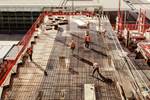ACI publishes code requirements for GFRP rebar
New comprehensive building code requirement covers the use of nonmetallic, GFRP reinforcing bars in structural concrete applications that are covered by ACI 318-19.
The American Concrete Institute (ACI, Farmington Hills, Mich., U.S.), through the work of ACI Committee 440, has released ACI CODE-440.11-22: Building Code Requirements for Structural Concrete Reinforced with Glass Fiber-Reinforced Polymer (GFRP) Bars. The code was developed by an ANSI-approved consensus process and addresses structural systems, members and connections, including cast-in-place, precast, non-prestressed and composite construction.
This is reported to be the first comprehensive building code covering the use of nonmetallic, GFRP reinforcing bars in structural concrete applications. GFRP reinforcement has been in use for decades as an alternative to steel reinforcement because of its non-corrosive, non-magnetic and lightweight properties. According to ACI, this code represents a milestone for this technology, and mirrors ACI 318-19 with provisions for designing GFRP-reinforced concrete beams, one-way and two-way slabs, columns, walls, connections and foundations. Other model codes and standards can directly reference ACI CODE-440.11-22 to enable widespread, responsible use of this important technology.
“What really sets this code apart is that it is dependent on ACI 318-19,” Will Gold, past chair, ACI Committee 440, says. “With this new code, almost almost any structural element covered by ACI 318 can be designed using GFRP reinforcement instead of steel reinforcement. A great deal of new research and validation was required for the code to address elements such as connections and columns. The hard work and efforts of many ACI Committee 440 members made development of this new code possible, and it represents a tremendous accomplishment by the committee.”
ACI Committee 440’s mission is to develop and report information on fiber-reinforced polymers (FRP) for internal and external reinforcement of concrete. Committee 440 has written and maintains a number of design guides, materials and construction specifications, reports and technical notes on the use of FRP in structural concrete applications.
Related Content
-
Materials & Processes: Fibers for composites
The structural properties of composite materials are derived primarily from the fiber reinforcement. Fiber types, their manufacture, their uses and the end-market applications in which they find most use are described.
-
Materials & Processes: Composites fibers and resins
Compared to legacy materials like steel, aluminum, iron and titanium, composites are still coming of age, and only just now are being better understood by design and manufacturing engineers. However, composites’ physical properties — combined with unbeatable light weight — make them undeniably attractive.
-
PEEK vs. PEKK vs. PAEK and continuous compression molding
Suppliers of thermoplastics and carbon fiber chime in regarding PEEK vs. PEKK, and now PAEK, as well as in-situ consolidation — the supply chain for thermoplastic tape composites continues to evolve.







.jpg;maxWidth=300;quality=90)






